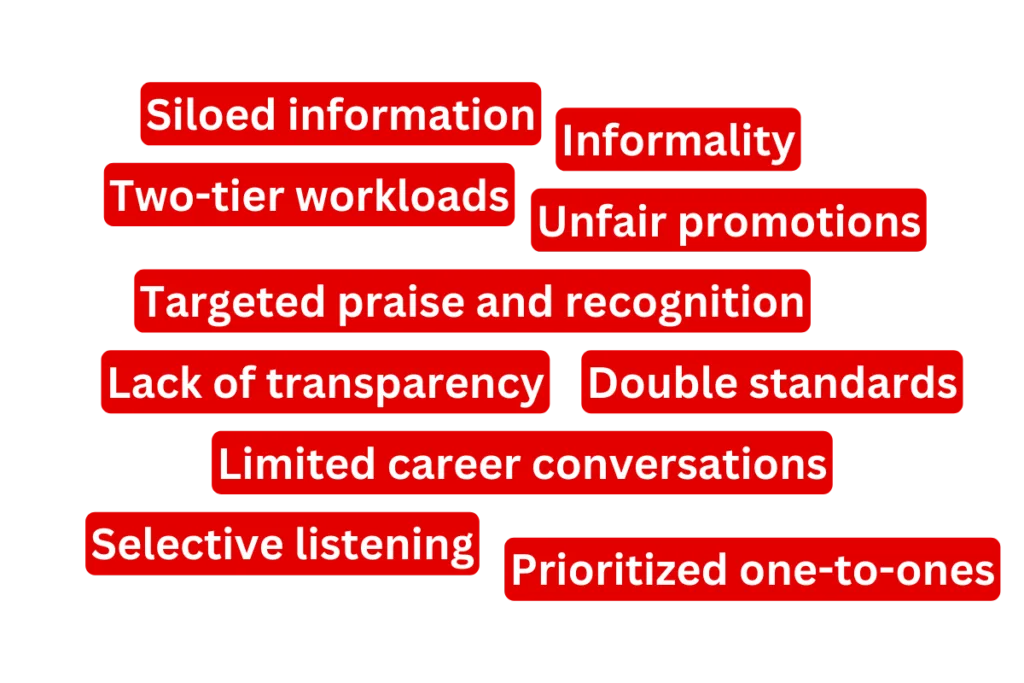We all have our preferences. Some people like reality TV, and others hate the idea of tuning into the latest Real Housewives franchise. Some people want to spend all their vacation lying next to a pool or on a beach, while others want to be out exploring from dawn until dusk. However, one place where preference really should have no place is our social interactions in the office.
Preferential treatment or favoritism at work can be demoralizing to encounter and difficult to overcome. Acknowledging that you are the favorite and asking for a redistribution of power can also be challenging, as it requires the behavior of your leader to change, which is something ultimately out of your control.
We all know that workplace favoritism is nothing new. So long as we have been coming together in a workplace, whether that has been a modern office, a factory, or even medieval farmers in a field, people in power have probably been exhibiting preferential treatment to their favorites. However, ignoring it can lead to a lot of issues.
Research shows that 1 in 5 workers say that their employer doesn’t care about their well-being much or at all, and that 55% of workers don’t have someone who they consider a mentor. When we are not the favored employee, we can be left feeling alone. Knowing how to spot and confront favoritism at work is the first step to challenging the systemic issues that allow it to dominate in the first place.
Summarize this blog post with:
Unconscious Bias Is a Leading Cause of Workplace Favoritism. Take Our Quiz to Check Your Own
10 signs of favoritism in the workplace
Some favoritism in the workplace is blatant; other times, it is much more subtle. These are some common signs of favoritism that we tend to see, but this list certainly isn’t exhaustive.

1. Siloed information
When we talk about siloes here, we don’t mean grain storage, but rather a halt in sharing information within a business. This can be intentional, as we often see with workplace favoritism, but it can also be passive because the root cause of information siloing can be a dozen different factors.
If siloing does occur because of favoritism, we usually see information being passed along to certain employees only and not to the full team. Let’s imagine that a company CEO has a better relationship with their Head of Sales compared to their other department leads. Sales then receives trend and customer insights that the others do not. Though this data could be put to use in places like Marketing or Product Design, it is hoarded by the sales team.
2. Double standards
One rule for them, another for the rest. One of the fastest ways to identify favored employees will be when double standards arise in their treatment compared to everyone else. Even if the rest of the office is pulled up time and time again for supposed indiscretions, this one particular employee never receives any corrections.
Let’s imagine that a product designer, Matt, has had a vacation request in the diary for months, and it is an important one; he’s going to be the best man at his brother’s wedding! He gets a message from his brother that their other family members are getting to the resort a day early to relax and catch up before the big day. When Matt approaches his manager, Alan, to ask for the extra day, he gets shut down immediately and is told he can only have the pre-approved time off. Matt later finds out that one of his colleagues, Mike, asked Alan for the coming Friday off to meet an old friend who will be in town for the day. Mike’s impromptu request was granted with no question whatsoever. tktktk
3. Promotions
When favoritism is in the office, it can wreak havoc with promotions and career advancement. The wrong employees are moving up because they have personal relationships with decision-makers, not because they have the skills and experience to help them thrive in the role.
As an example, a company has two senior executives they are considering for promotion, John and Jane. Jane has consistently delivered results in her time at the organization and is well-liked by her colleagues. On paper, she is the better candidate. However, John is friendly with the VP who makes the final decision. They play golf on the weekends and socialize outside the office, and the VP often gives high-profile tasks to John. Due to the favoritism at work, John is promoted over Jane.
ESPN’s Strategy for Defeating Favoritism?
Peer Mentorship
Result: 92% Satisfaction Rate.
Download the case study to learn how they did it
4. Targeted praise and recognition
It can often seem like only favored employees get praise and recognition in an office where favoritism is rampant. Other employees feel like nothing they can do is good enough, while the favorites receive recognition for anything that they might do.
Let’s return to John and Jane for a moment, as their scenario shows this quite clearly. John is given many high-profile tasks that he completes to varying degrees of success. Jane is given a greater volume of tasks, many of which are also more challenging than those John typically handles. However, none of them are as high-profile as John’s, so Jane feels she receives little to no praise for the work she does.
5. Lack of transparency
If a company does not provide clear and standardized routes for advancement, this lack of transparency might breed favoritism and distrust. When employees don’t know how to put themselves forward for a promotion, they will inevitably turn elsewhere and consider roles with other companies.
Let’s consider the example of Raj: a talent acquisition executive who has consistently made good hires for the company and receives great feedback from his candidates, even when delivering bad news to them. He wants to move to a more senior position in the HR department, but he lacks a mentor to help him get where he needs to be. Decisions about promotions are made in closed meetings he is not invited to, and when he is passed over for one promotion he goes for, he only receives generic feedback that actually doesn’t teach him anything. The lack of transparency and aid from his seniors demoralizes him, and this could begin to affect other areas of his performance.
6. Selective listening
Selective listening is usually the ability to pick one voice out of a mess of noise, such as focusing on your friend’s story in the middle of a busy restaurant. We are appropriating it slightly here to talk about a common occurrence of workplace favoritism. One employee makes a suggestion, it could be about anything, and a supervisor dismisses it. Their favored employee then makes exactly the same suggestion, and now the supervisor adores it.
In a marketing meeting, the Gen Z intern, Tom, suggests that the company leverage a certain TikTok trend that has been popular recently. He makes a good case for how it can bring attention to the company, but the marketing manager, Liz, dismisses the idea. A few minutes later, another member of the team, Cassie, speaks up and suggests a “new” idea that the company leverages a certain popular TikTok trend. The rest of the team immediately sees that she has copied Tom’s idea, but Liz doesn’t. She loves it, gives Cassie all the praise and credit for the idea, and even goes so far as to ask Tom to support Cassie with the task. Tom is outraged but knows he will be dismissed further if he tries to call out this unfair treatment.
7. Limited career conversations
Career conversations can help both junior and senior members of a team understand how they want to explore their future within the company. Having a career conversation with a trusted colleague can be invaluable, but having one when you are not a favored employee can quickly leave you feeling demotivated.
Polly is a newly hired sales executive and is invited to hold a career conversation with her mentor, Paul. Throughout the meeting, he seems disinterested in what she has to say and is even dismissive of some of her plans and ambitions for the future. Polly leaves the meeting upset and then discovers that another of her team, Lana, is also mentored by Paul and has had a career conversation with him. Lana cannot speak highly enough of Paul and tells Polly about all the insights and connections he has given her. He clearly favors Lana over Polly, leaving her deserving of a mentor who can help her flourish.
8. Prioritized one-to-ones
One-to-ones are a great time for people to sit down and ensure that everything is aligned and on the same page. However, an unfair distribution of one-to-ones can cause employees to feel disengaged and demotivated. When a one-to-one is needed but the favored employees all seem to get them first, it can frustrate and annoy the ignored colleague.
Remember Raj? He wants to get on a one-to-one with his manager, Anton, to again ask why he has been passed over for promotion and to find out if he can try the company’s mentoring program. However, Anton is dismissive and evasive. He claims he is too busy to fit Raj in and asks him to sort it out himself, all while scheduling one-to-ones and other meetings with Raj’s colleagues. Raj feels unsupported and is more motivated than ever to find a new role that gives him the guidance he craves.
9. Two-tier workloads
We’ve already seen two-tier workloads being mentioned above, but they are worthy of their own explanation. When workplace favoritism is at play, certain employees may be given the pick of tasks first, leaving the more challenging or less interesting tasks to other colleagues.
If you remember, this is something we have seen with Jane and John. John is being awarded and recognized for the high-profile tasks he completes, while Jane works hard and delivers great results for her workload yet never receives praise for it. The more Jane and the wider team see John receive praise for his mediocre results, especially after his undeserved promotion, the more resentment of John grows.
10. Informality
There is no one right way to lead, and everyone who steps into a position of leadership needs to find their own way to handle the many nuances it can bring. Some decide that they don’t want to rule with an iron fist and instead want to be more of a friend to their employees. When the employees don’t return the informal vibes, the leader lashes back.
Polly encounters this when she notices that Lana is always joking around with Paul. The two speak to each other quite informally and seem to share a personal relationship that goes beyond the office. However, Paul’s jokes make Polly uncomfortable, and she voices that she would rather maintain a level of professionalism with him. This causes Paul to become cold to her, and the difference in the way he treats Lana and Polly becomes very obvious to others within the team.
What should we do when we see favoritism in the workplace?
When we feel like someone is receiving preferential treatment over us, it can be difficult not to get emotional in some way. However, we need to try to make sure that we keep a calm head and instead look to combat favoritism through other means. Should you discover favoritism, you should bear the following points in mind:
1. Stay rational
The first thing anyone must do when considering whether or not a situation has been influenced by favoritism is to try to stay rational. It is so easy to jump to conclusions when we feel slighted, but it is important to remember that we are just one of many talented employees in an organization. Though you might feel slighted by the treatment you have received, did the employee with more favorable treatment actually do something to deserve it?
They may have a technical qualification that you don’t, or they may have better soft or interpersonal skills than you. As hard as it is to hear, sometimes we aren’t the right fit for certain projects, and a little rational thinking can show the truth.
2. Discuss with someone removed from the situation
Sometimes, it is worth stepping back and discussing the situation with someone who can see everything rationally but is themselves removed from it. Discussing with friends or a partner can be a great start for offloading your stress, but these people are ultimately on your side. To reach a fair conclusion, the better person to speak to might be a mentor.
Present your mentor with your overview of events, and try to keep your descriptions as neutral as possible. They may have constructive feedback for you that is a little hard to hear, or they may agree with what you have to say. Together, try to work towards a plan of action so managers don’t practice favoritism so easily in the future.
3. Advocate for yourself
If you decide to confront the manager who favors others, you need to be prepared to advocate for yourself. Sometimes, favoritism is deliberate; other times, the leader may genuinely not realize that they have been uplifting some of their team to the detriment of others.
Whether they know it or not, a manager can become dismissive of your claims of preferential treatment. They could try to claim it never happened, or a more negatively minded manager could try to point out flaws in your own employee performance. You need to present them with facts and specific examples of their favoritism. Speak calmly and clearly, and ensure that you are properly advocating for yourself and other more deserving employees.
What can we do when we receive preferential treatment?
Sometimes, we are the ones receiving preferential treatment. Though one might think it is nice to be supported and looked after by management, it can cause a disconnect with the rest of the team. If a team member chooses to hold a grudge against you because you are the favored one, the animosity can result in poor performance all around. Instead, address the situation like this:
1. Talk to your colleagues
Make your other team members aware that you know you are being treated better than they are, and express your discomfort with the situation if necessary. Confirm that there is indeed a bias towards you, and be open and honest about your plans to discourage favoritism moving forward.
2. Acknowledge the behavior
You can’t simply acknowledge that favoritism is present and then move on like there is nothing to correct. Acknowledge the behavior towards you and bring it to the attention of those giving it to you. If you will be receiving a promotion or bonus that you think is being given due to favoritism rather than your actions, ask management to reconsider the decision.
3. Advocate for your colleagues
To combat favoritism at work, you need to be prepared to advocate for your colleagues. When you are the only one praised for a group project, acknowledge the contributions of your team members and try to divert praise to them, too. Invite your colleagues to speak when you are called on but they are more capable. Keep the spotlight moving off you and let them shine the way they are supposed to.
What can leaders do to prevent favoritism?
Of course, leaders need to be aware of their own tendency to choose favorites. It is human nature to form connections, and there will be some members of your team who you will naturally feel closer to than others. There is no excuse for treating others unfairly. Here are some actions you can take as a leader to mitigate potential favoritism in your actions:
1. Identify and challenge your own biases
Everyone has biases. As a leader, you need to identify your personal biases so you can work to avoid them. These can be as simple as preferring to work with someone because you have more in common, or it could be some deep-seated biases and misconceptions that will take you a lot of work to recognize and overcome. No matter what, an effective leader must be able to overcome their biases.
2. Be aware of your actions
Favoritism can often crop up because the leader is unaware that it is happening. You might think you always choose a certain employee to do a high-value task because they are the best at it, when it might be because you are subconsciously biased towards their work (indicating why understanding your biases is so important!). Recognize when you display favoritism and what triggers it, and then work to mitigate this behavior.
3. Find support and help
Working on oneself is difficult alone. Finding the right mentor can be invaluable. Within a mentoring relationship, you will have a willing ear to help you work out where and how improvements must be made. They will hold you accountable for your actions, and give you insights you might not have been able to glean on your own.
4. Address the systematic cause of favoritism
Why has favoritism been allowed to take root in your organization in the first place? Taking a look at the systems and cultures at play within your company can help everyone recognize that there is an issue. Introduce a system of rotating responsibilities — where everyone on a team handles high-profile tasks and, thus, no one receives special treatment — and give everyone access to mentoring programs and career development opportunities.
5. Establish clear criteria for recognition
Everyone deserves to receive recognition for something. However, handing out praise arbitrarily can leave job satisfaction lagging as no one knows whether their actions are deserving of reward. Clear criteria for recognition help everyone to know where they stand and what they need to do to be worthy of praise.
6. Formalize performance reviews
Unstructured performance evaluations can hinder employee development as it leaves employees confused as to where they should go next in their career journey. Introducing a standardized review connected to measurable KPIs provides open and honest evaluation to all and helps to showcase talent and merit. Don’t just keep it to management; implementing a 360-degree regime built around the concept of feeding forward allows everyone to contribute to a wide perspective from workplace peers, not just the manager-centric viewpoint.
Is favoritism the same as discrimination?
In many of the instances above, the actions of the team leader may look like discrimination. This is especially true when minority or underrepresented employees feel like they are being overlooked in favor of others. However, acts of favoritism are not always acts of discrimination. Since the latter is illegal, we must know the difference so we can appropriately deal with it.
- Favoritism stems from personal biases and preferences and does not necessarily violate the law. For example, a manager assigns work to the junior they are most socially compatible with so they can work alongside them frequently, ignoring the rest of the team.
- Discrimination also stems from bias, but it arises due to negative and unfair behavior toward an individual or group with protected characteristics such as race, sexuality, or disability, to name a few. For example, some employees are not allowed time off to celebrate their religious holidays, while others have holidays off whenever they want them.
Both will create a difficult and uncomfortable working environment, and both can cause severe damage to a workplace, such as a lack of trust or a high turnover of employees. However, discrimination is much more serious and can carry legal risks not just for the discriminatory manager but for the company at large. When we encounter illegal discrimination we should fight against it, but to do so will require a lot more strength than simply calling out favoritism.
If you think you are facing discrimination rather than favoritism, consult your HR department or seek legal advice on how to proceed.
DEI
There, we said it.
It’s the key to fixing problems with both
favoritism and discrimination.
Check out our eBook: 3 Essential DEI Success Strategies
Find the right people to uplift you with mentoring
Favoritism at work can leave us feeling isolated and like there is nothing we can do to improve our situation when this simply isn’t the case. Having the right people on your side can uplift you and show you the value you hold when others may dismiss it or refuse to recognize your achievements.
Finding the right mentor can be invaluable. They will hopefully be removed from the situation and can advise you on how best to navigate it. With their guidance, you can also make a plan of action to better yourself, gain new skills, and network new connections until this era of being overlooked is nothing more than a line of summary on your resume.
MentorcliQ helps take the hard work out of matching mentors with the right mentees. Our software makes it easy for you to launch and scale mentoring and ERG programs where employees can find support and a voice to help them take their careers to the next level. Book a demo today to find out more.





